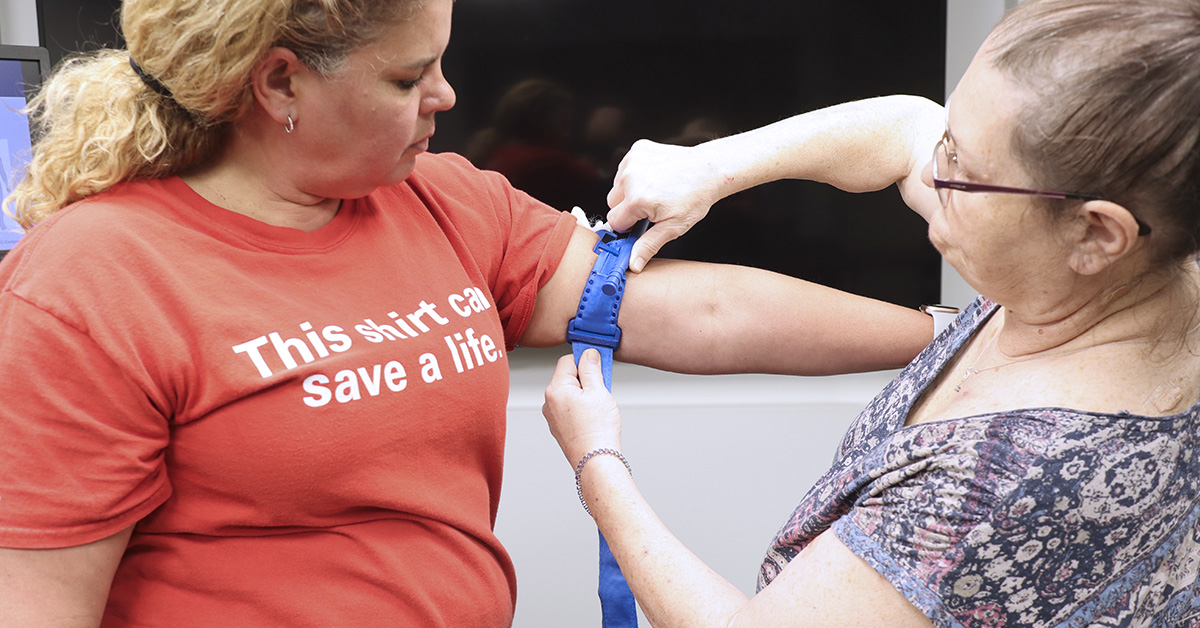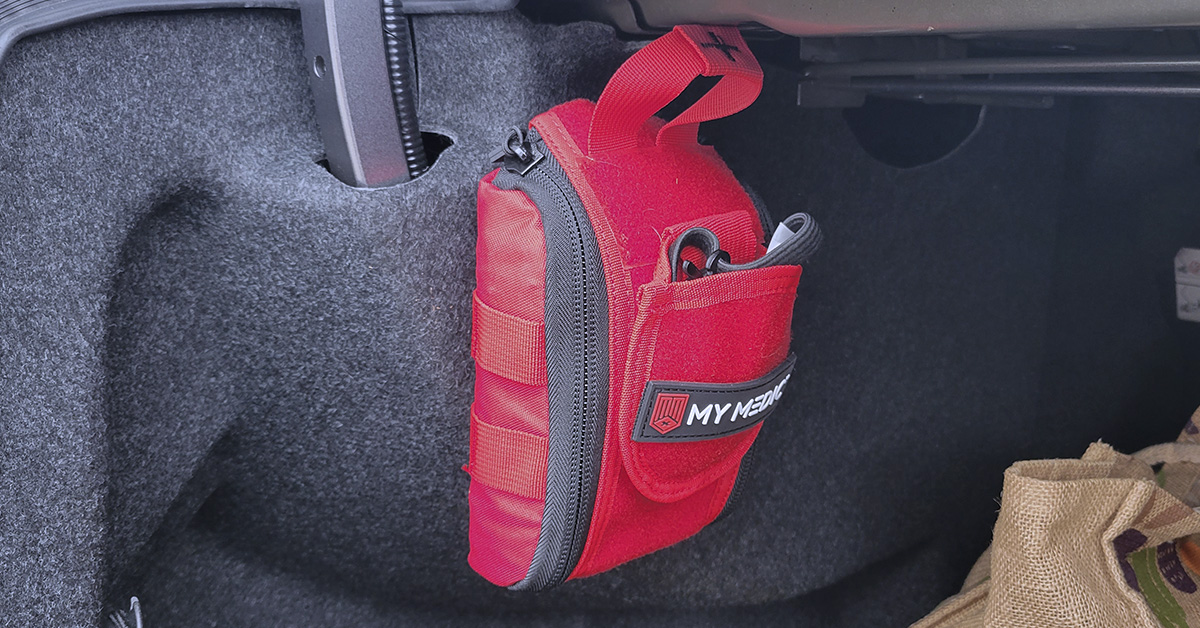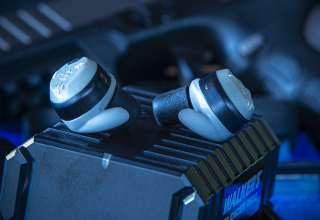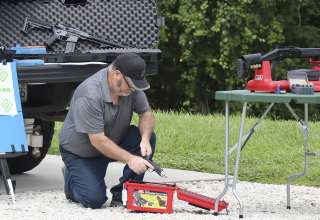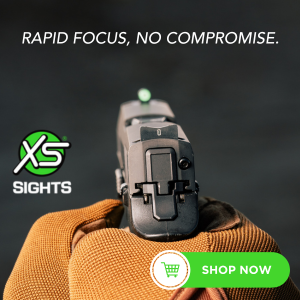Whether it is at the range, hiking in the woods, or simply driving down the interstate, having a trauma kit at the ready could save a life, including your own
by Mark Houlahan
Not long ago we shared our thoughts on essential range day gear that would make a day at the range, public or private, an enjoyable one. We covered some great products from our friends at MTM-Case Gard and Real Avid in said piece, but we had a firearm instructor friend call us on a “big miss,” as he referred to it. That big miss was lack of inclusion of a First Aid or trauma/IFAK (Individual First Aid Kit) for the range.
Good call. We were so focused on the shooting gear that we overlooked one of the most essential pieces that should be in your range bag (…and your backpack..and your car).
This all stemmed from our friend having dealt with a fellow shooter’s negligent discharge after a match at the gun range where he is an instructor. Thankfully, he and his fellow instructors not only had the training, but also the proper gear to stop the bleeding and stabilize the person until an ambulance arrived on scene. The good news was this person was not alone but in the company of trained people with the right gear. Of course, having cell service and being where an ambulance could be dispatched in a timely manner also helped, but that’s not always the case.
All of this began the process of researching the proper gear and the training to deal with a major trauma. And that led us to Stop the Bleed.
The Stop The Bleed campaign is a program administered by the American College of Surgeons and their committee on trauma. Through medical advances in military medicine made during the wars in Afghanistan and Iraq, which have been brought back stateside and passed to the general public via free Stop The Bleed training programs, the goal is to raise awareness of basic procedures to stop life threatening blood loss from everyday emergencies. From power tools to impalements, animal bites, car accidents, and, of course, gunshot wounds, the major loss of blood is the number one concern.
These free Stop The Bleed classes are held all over the United States and provide not only hands-on instruction in major blood loss scenarios where you’ll need to use compression bandages, wound packing gauze, or even a tourniquet, but also include educational aspects on maintaining your own safety, the minimum equipment needed, and more.
While the Stop The Bleed courses are designed for training you in rendering aid to a person, there is much discussion on self-aid as well and how to stop the bleeding of your own wound if you are by yourself.
We recently took a Stop The Bleed course, and though we carry a basic First Aid kit in our vehicle, we know now that we need to upgrade that kit, build our own custom trauma kit, or buy a complete kit ready to go. For our trauma kit needs, we partnered with My Medic so we could have the right gear for our next range session, have our car fully stocked for the next road trip, and be ready for our next outing in the woods.
Get Training
There are several options for receiving proper trauma training. Your First Aid or BLS course is a good start, as is CPR for both adults and children, but none of these focus on stopping major bleeding trauma. We do encourage you to take these courses with hands-on training as well. I have basic First Aid training but am not CPR certified. That is something else I will be accomplishing soon. As stated earlier, the Stop The Bleed training is completely free, so you should certainly take advantage of the opportunity if a class is available in your area. Stop The Bleed holds classes all over the country, so the best thing to do is hit their training schedule to see what classes are coming up.
The Stop The Bleed courses are generally an hour in length and held at hospitals, fire departments, education centers, and other such locations. The class the wife and I took was at a hospital and our instructor even stayed after the hour was up to answer more questions one-on-one and to allow more hands-on training with the sample trauma kit materials. Our group size was roughly 12 individuals, ranging from Boy Scout troop leaders to over-the-road truckers, firearm and hunting enthusiasts, and more. You’ll get a chance to practice what you learned right there in the classroom and examine some of the North American Rescue (NAR) products that Stop The Bleed offers on its website.
Our instructor for our Stop The Bleed course was Dawn Lewis, the Trauma Program Manager for Tampa General Hospital (TGH) in Florida. The course was held at TGH’s Brandon Healthplex. Here, Dawn is walking the class through the slide show presentation, which takes up the first half hour. The slide show presentation includes aspects on controlling the accident scene, your own personal safety, and more.
Hands-on training in the class starts with compression bandage use on the sample training leg — part of the Hemorrhage Control Trainer (HCT) kit that is used in the class. Once the class has practiced wrapping the training leg with a compression bandage, the next live training operation is wound packing.
Wound packing is a critical bleeding response that may be required for deep wounds. While there were several HCT training legs and gauze/bandages to go around, Dawn helped several attendees ensure they were performing the procedure properly. One thing Dawn stressed is that wound packing is painful, but can save someone’s life, and it is best to do it quickly while explaining to the injured person that it is a painful but lifesaving process.
The final aspect of the hands-on training is the proper application and allowed locations of using a tourniquet. The tourniquet used in the class is NAR’s CAT Gen7, the official tourniquet of the U.S. military branches. This is a popular and easy to use tourniquet that the class practiced applying on each other. Use of the SOF Tactical Tourniquet (SOFTT or SOF-T) and other tourniquets were discussed as well.
At the end of the class, a certificate is provided for the completion of the course. Depending upon your health insurance program, this class may be eligible for your health insurer’s health “points” program, just like a CPR class.
Like any training, it is good to take the course again to refresh your skills or to observe any changes in training or new bleeding control products. The ACS does not restrict how many times you can take the class, so feel free to sign up for a refresher in the future or take their virtual class. Note that the virtual class does not provide any certification, as the instructor must see that you understand and can properly use the bleeding control products, but the virtual class is great for use as a refresher course.
Building Out Your Trauma Kits
Now that you have the proper training to understand and to use bleeding control products, it is time to step up your First Aid supplies. If you have a solid First Aid kit already, you may only need a few items, such as a tourniquet and some compression bandages (often called Israeli bandages) to supplement what you’ve already built out. Or, if you’re completely lacking in First Aid or looking to add an additional kit (one for the range bag, one for the truck or RV, etc.), there are plenty of great options. Obviously, Stop The Bleed has several offerings on their website, including their Premium Personal Stop The Bleed Kit shown here. These items are made for Stop The Bleed by North American Rescue, which has expanded offerings on their website as well.
As mentioned, we sourced several great products from My Medic, including the complete TFAK trauma kit, Popular Mechanics The Auto Medic First Aid kit, a SOFTT tourniquet, emergency pressure bandages, wound closure strips, and more. These items will be used to supplement our existing First Aid kits and provide enhanced bleeding control options for when we’re hiking, at the range, or wherever. The great thing about the My Medic products is they offer refill kits, so if you end up using part of your trauma kit in an emergency, you don’t have to order a new trauma kit, just the items you need to refill. Most products on the My Medic website also includes “how to use” training videos.
Obviously, there are some great choices for First Aid and trauma supplies out there, but we strongly recommend you stay away from eBay and Amazon, as there are a lot of knockoff products on these sites, especially tourniquets. If you do take this route, be sure you are buying from an official brand store or go directly to NAR, Stop The Bleed, or My Medic’s websites to guarantee first rate products. The last thing you want is your tourniquet to fail during application!
This is the full contents of the My Medic TFAK kit. The diminutive size may mislead you at first, but you have everything you need in one compact package to control trauma level bleeding. The included Rapid Action Tourniquet System (RATS) tourniquet isn’t quite as easy to use as a SOFTT or CAT, but is still a viable solution, especially for those with small limbs, including children. This is why we picked up the SOFTT tourniquet as well — so we’d have both to cover any situation.
The TFAK’s case includes a hook and loop tear away system to provide quick access from a storage location, such as a wall at the range, your vehicle’s headrest or a MOLLE panel, and the included RATS tourniquet pouch can be grabbed separately without having to open the TFAK and dig for it. Rear snap loops are provided for MOLLE panel systems on your range bag or backpack. This pack is sized well to carry in your range bag or can be carried on your belt.
We found that the hook material on the TFAK backing (once you remove the rear panel with snap loops) will secure the TFAK to the typical trunk trim material used on side panels and floors of most trunks or hatches. This provides secure storage away from prying eyes yet is quickly accessible in an emergency.
The Auto Medic, while slightly larger than the TFAK, is still very easy to store in your vehicle. Our plan is to leave The Auto Medic in the car and the TFAK will switch out between our range bag and our hiking backpack as needed.
While The Auto Medic is not specifically branded as a trauma kit for major bleed scenarios, it does include a RATS tourniquet, compressed gauze, bandages, EMT shears, saline wash for wound flushing, disposable gloves, and more in icon-marked mesh compartments. So, while it is a great solution for the car, including burn and bug bite ointments, window breaker/seatbelt cutter, ibuprofen tablets, and other items to handle any road trip emergencies, you have the basics on board for a major bleed emergency as well.
We picked up several of these safety packs from a local Farm & Fleet supply store on sale. Their contents are designed more for your own protection and do not include any lifesaving supplies. We keep one or two in every vehicle and have started stashing them in our camping gear and range bag to supply other on-scene assistants. As most First Aid or trauma kits only include one pair of gloves, this will allow you to provide gloves and masks for anyone willing to help.
These nifty little devices from My Medic are called Billy Bands. They allow you to attach just about anything to a MOLLE panel like those on the side of soft rifle cases, range bags, and backpacks. For quick access without digging through your day pack, you can simply use a Billy Band to secure the item.
We added our SOFTT tourniquet to our My Medic The Auto Medic kit using a Billy Band. This allows us to quickly grab the tourniquet right off the First Aid kit with our backup RATS tourniquet stored inside the First Aid kit. With this, it is possible to help more than one person, or to apply a second tourniquet above the first if the first tourniquet has not occluded the bleeding.
My Medic’s line of individual med packs and supplies allows you to not only resupply your trauma kits after use, they are also the perfect items to supplement a basic First Aid kit or build out a complete custom First Aid/trauma support solution for you needs. You can even purchase empty TFAK or other trauma kit bags from My Medic to use as a basis for your own custom load outs or simply purchase the individual items you need and store them in a dedicated pocket of your range bag or backpack. Going the individual product route allows you to build an IFAK to wear on your belt or ankle, or to build a larger multi-person kit to protect your whole family. Of course, you can simply choose to carry a tourniquet on your belt or in your pocket as well.
Shown here are the RATS, SOFTT, and CAT tourniquets, from left to right. The RATS is a good option (especially for smaller limb diameters like children) but takes some training to use in our opinion and can be awkward to use one handed (on yourself). The SOFTT and CAT are both similar in design, using an easy-to-pull-tight wide strap and then a windlass system to tighten the tourniquet to stop blood loss. You’ll notice we ordered our SOFTT in red and our CAT in orange. They are generally available in black, red, orange, and blue. The blue models are often used for training (look back at our classroom photo earlier in this article) and should not be used “in the field.” We like the red and orange, as they’re easier to spot in medical kits or in the bottom of a range bag or backpack, but if you’re a tacti-cool type, then black it is!
- Active In-Ear Protection is “IN!” - August 21, 2023
- Are You Prepared to Stop the Bleed? - February 13, 2023
- Range Day Essentials - September 19, 2022





